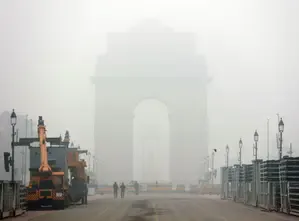Delhi's Air Quality Declares 'Poor' Status; Cold Wave and Heavy Fog Persist

New Delhi, Jan 13 (NationPress) After enduring weeks of air quality classified as very poor, Delhi has experienced a notable improvement, with the Air Quality Index (AQI) measured at 282, thereby categorizing it as poor on Monday at 8 a.m., as reported by the Central Pollution Control Board (CPCB).
Even with this improvement, a cold wave continues to envelop the capital, along with dense fog that has drastically limited visibility during the early morning and night.
The India Meteorological Department (IMD) issued a yellow alert for dense fog on Monday, warning residents about possible disruptions.
The day commenced with chilly winds, and the IMD forecasts a primarily clear sky, with smog or shallow fog expected to develop in the evening and nighttime. The maximum temperature is predicted to be around 19 degrees Celsius, while the minimum temperature could drop to 7 degrees Celsius.
Recent rainfall, caused by a western disturbance affecting northwest India, significantly contributed to the improved air quality. Consequently, the Commission for Air Quality Management (CAQM) announced on January 12 the lifting of Stage III restrictions under the Graded Response Action Plan (Grap) for Delhi-NCR.
Nevertheless, Stage I and II measures will continue to remain in effect to guarantee ongoing improvements in air quality.
The removal of Stage III restrictions relaxes limitations on private construction and demolition activities, reinstates regular offline classes for students up to Class 5, and permits BS-III petrol and BS-IV diesel four-wheelers to operate without restrictions. Furthermore, non-essential BS-IV diesel-operated medium goods vehicles (MGVs) are now allowed to operate.
As the western disturbance weakens, the IMD anticipates a decline in minimum temperatures starting January 14, with cold northwesterly winds expected to return, increasing the chill in the region.
Residents are encouraged to prepare for the shifting weather conditions while following ongoing pollution control measures.










